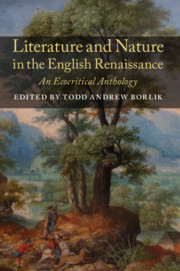Book contents
- Frontmatter
- Contents
- List of Illustrations
- Acknowledgements
- Editorial Principles: Towards the Ecocritical Editing of Renaissance Texts
- Introduction
- PART I Cosmologies
- PART II The Tangled Chain
- PART III Time and Place
- Seasons
- Country Houses
- Gardens
- Pastoral: Pastures, Meadows, Plains, Downs
- Georgic: Fields, Farms
- Forests, Woods, Parks
- Heaths, Moors
- Mountains, Hills, Vales
- Lakes, Rivers, Oceans
- PART IV Interactions
- PART V Environmental Problems in Early Modern England
- PART VI Disaster and Resilience in the Little Ice Age
- Appendix A Industrialization and Environmental Legislation in the Early Anthropocene: A Timeline
- Appendix B Further Reading: A Bibliography of Environmental Scholarship on the English Renaissance
Heaths, Moors
from PART III - Time and Place
Published online by Cambridge University Press: 05 June 2019
- Frontmatter
- Contents
- List of Illustrations
- Acknowledgements
- Editorial Principles: Towards the Ecocritical Editing of Renaissance Texts
- Introduction
- PART I Cosmologies
- PART II The Tangled Chain
- PART III Time and Place
- Seasons
- Country Houses
- Gardens
- Pastoral: Pastures, Meadows, Plains, Downs
- Georgic: Fields, Farms
- Forests, Woods, Parks
- Heaths, Moors
- Mountains, Hills, Vales
- Lakes, Rivers, Oceans
- PART IV Interactions
- PART V Environmental Problems in Early Modern England
- PART VI Disaster and Resilience in the Little Ice Age
- Appendix A Industrialization and Environmental Legislation in the Early Anthropocene: A Timeline
- Appendix B Further Reading: A Bibliography of Environmental Scholarship on the English Renaissance
Summary
The British landscape is chequered with heath: open shrubland with acidic soil that is not conducive to farming. At high elevations, heaths are known as moors, and the UK contains roughly 10–15 per cent of the moors in the world, mainly in Devonshire, Staffordshire, Yorkshire, and Scotland. Although not nearly as biodiverse as wetlands, heaths provide a vital habitat for several rare and endangered species. In the following dialogue, the surveyor John Norden (an advocate of agrarian improvement and what we would now call sustainable growth) recognizes that heaths vary from place to place, and proposes methods by which some of them might be converted into arable land to help feed England's growing population. The campaign met with some success, as the heaths are much smaller today than they were in Tudor times.
Source: The Surveyor's Dialogue (1607), 234–7.
BAILEY But what say you to this heathy ground? [235] I think of all other grounds, this is the most unprofitable.
SURVEYORZ I ndeed, naturally all heathy grounds are barren, and that comes by the saltiness of the soil … for salt is hot, and heat drieth, and too much drought breeds barrenness and leanness … Therefore, though heathy grounds be commonly in the highest degree of barrenness, yet are some more … tractable and more easily reduced to some use than others, and therefore hath sundry names. Heath is the general or common name, whereof there is one kind called Heather, the other Ling. And of these particulars, there are also sundry kinds distinguished by their several growth, leaves, stalks, and flowers: as not far from Gravesend there is a kind of Heather that beareth a white flower and is not so common as the rest, and the ground is not so exceeding barren as some other, but by manurance would be brought to profitable tillage. Some (and the most) doth bear a purple or reddish flower, as in the Forest of Windsor and in Suffolk and sundry other places: and this kind is most common, and groweth commonly in the worst ground. In the North parts, upon the Mountains and Fells, there is a kind of Ling that bears a berry.
- Type
- Chapter
- Information
- Literature and Nature in the English RenaissanceAn Ecocritical Anthology, pp. 286 - 291Publisher: Cambridge University PressPrint publication year: 2019



